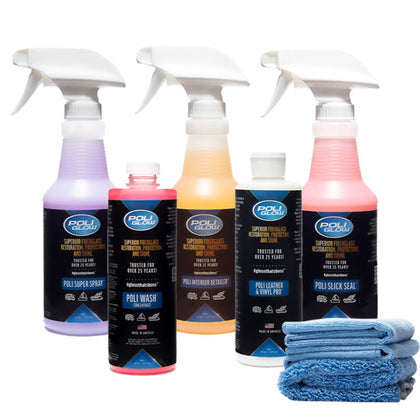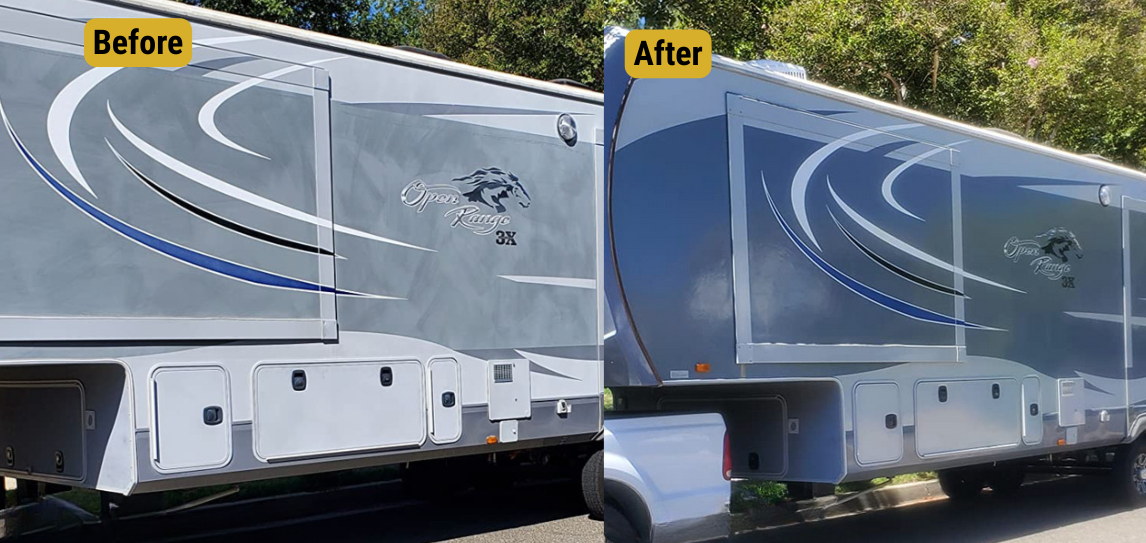
A Step-by-Step Guide: How to Wax a Boat for a Gleaming Finish
Time to read 15 min

Welcome to our blog post, where we delve into the world of boat maintenance and protection. In this comprehensive guide, we'll be shedding light on an essential aspect of boat care: boat waxing. Boat wax is a crucial protective coating that comes into play after the boat has undergone cleaning and polishing. Its role is paramount in safeguarding your vessel against the various environmental challenges that accompany life on the water.
Unlike the products used in the earlier stages of boat care, Boat wax serves as a final layer of defense against the elements. It forms a shield against the harmful effects of UV rays, saltwater, pollutants, and other environmental factors that can wreak havoc on your boat's surface. By creating this barrier, boat wax acts as a powerful preventive measure, combating the onset of oxidation, fading, and potential damage to the boat's overall finish.
However, the benefits of boat wax extend beyond protection alone. In addition to its defensive qualities, boat wax contributes significantly to the visual aesthetics of your vessel. It imparts a luxurious glossy shine that enhances the boat's appearance and gives it that well-maintained and polished look. Moreover, boat wax's water-repellent properties play a vital role in reducing the formation of water spots, ensuring that your boat remains streak-free and impressive, even after facing the challenges of water exposure.
Our upcoming segments will unravel the process of applying boat wax, outlining step-by-step instructions to help you achieve that coveted gleaming finish. We'll cover essential tips, techniques, and insights to ensure your boat waxing experience is effective and efficient. So, whether you're an experienced boater looking to refine your maintenance routine or a newcomer eager to learn the ropes, join us as we uncover the world of boat waxing and its invaluable contribution to keeping your boat in pristine condition.
Types of Boat Wax
Several types of boat waxes are available on the market, each designed to cater to different needs and preferences. Here are some common types of boat waxes:
- Carnauba Wax: Derived from the leaves of the carnauba palm tree, this natural wax provides a deep, warm shine and water-repellent properties. It's often used as a topcoat for added protection and shine.
- Synthetic Wax: Formulated with polymers and synthetic materials, these waxes offer enhanced durability and longer-lasting protection compared to natural waxes. They can provide a high-gloss finish and are suitable for boats facing harsh weather conditions.
- Hybrid Wax: Combining the benefits of natural and synthetic waxes, hybrid waxes offer a balance between the warm shine of carnauba wax and the longevity of synthetic wax. They're popular for those seeking the best of both worlds.
- Polymer Sealants: These advanced protective coatings create a strong barrier against UV rays, water, and pollutants. Although not strictly waxes, they provide similar benefits and are used as a long-lasting alternative to traditional waxing.
- Spray Wax: Convenient and easy to apply, spray waxes can be misted onto the boat's surface and wiped off with a cloth. They're ideal for quick touch-ups between regular waxing sessions.
- Liquid Wax: Easy to apply and spread, liquid waxes can be hand-applied or used with a machine buffer. They often offer a glossy finish and are suitable for boats with larger surfaces.
- Paste Wax: Coming in a solid form, paste waxes require a bit more effort to apply than liquid waxes. They provide a thick protective layer and a deep shine, making them suitable for boats exposed to extended sun and water exposure.
- UV Protectant Wax: Specifically formulated to provide enhanced protection against UV rays, these waxes help prevent fading, oxidation, and sun damage to the boat's finish.
Different waxes cater to various boat types and owner preferences, so take the time to explore and select the one that aligns with your specific requirements.
Identifying the Right Wax
Selecting the appropriate boat wax involves several considerations to ensure optimal results and protection tailored to your specific needs. Here's a guide to help you choose the right boat wax:
- Surface Material: Identify your boat's hull material – gel coat, fiberglass, aluminum, or painted surfaces – and choose a wax formulated for compatibility.
- Protection Needs: Evaluate your boat's exposure to harsh weather or UV rays. Opt for stronger UV protection for intense conditions and standard wax for moderate protection.
- Desired Shine: Decide on the level of shine you want – high-gloss or subtle – and select a wax that matches your preference.
- Ease of Application: Consider your experience with waxing. Choose user-friendly options if you're new to waxing, or opt for more complex products if you're comfortable.
- Frequency of Application: Determine how often you're willing to wax. Choose longer-lasting waxes or be prepared for more regular reapplication.
- Environmental Factors: Account for your boating environment – saltwater, pollution – and choose a wax that provides suitable protection.
- Product Reviews: Research reviews from other boat owners for insights into product effectiveness and longevity.
- Brand Reputation: Opt for reputable brands known for quality boat care products backed by research and development.
- Compatibility: Ensure the chosen wax works with existing coatings on your boat to avoid poor results.
- UV Protection: Prioritize waxes with enhanced UV protection to preserve color and prevent fading and oxidation.
- Budget: Set a budget, considering that quality products often deliver better and longer-lasting results.
- Application Method: Decide on spray-on, liquid, or paste wax based on convenience and coverage preferences.
By thoughtfully considering these factors and researching different boat waxes, you can select a product that meets your boat's unique needs. Adhering to the manufacturer's application and maintenance instructions will yield optimal results.
Dealing With Stubborn Stains and Imperfections
Before applying wax to your boat, attending to any persistent stains, oxidation, or imperfections on the surface is crucial. Tending to these matters ensures effective wax bonding and a polished finish. Here are techniques to gently restore the surface and ready it for waxing:
- Assessment: Examine the surface closely for stains, oxidation, or imperfections—note areas needing special attention, like water spots, bird droppings, or minor scratches.
- Mild Cleaning: Address light stains with a mild boat wash solution and a soft brush or sponge. Avoid harsh scrubbing to prevent further damage.

- Oxidation Removal: Combat oxidation with a dedicated remover or fine-cut compound. Follow product instructions, using a soft cloth or foam applicator to buff the area gently.
- Water Spot Removal: Dissolve stubborn water spots with diluted vinegar. Apply the mixture using a soft cloth and gently rub until the spots fade.
- Bird Droppings: Soften and remove bird droppings with a damp cloth, avoiding vigorous scrubbing to prevent scratches.
- Light Sanding: For minor imperfections, use fine-grit sandpaper (800 to 1500 grit) to sand by hand, preventing over-sanding gently.
- Rinse and Dry: After addressing issues, thoroughly rinse the surface with clean water and let it fully dry before waxing.
- Inspection: Check the surface after cleaning. If needed, repeat cleaning or restoration steps until you're satisfied.
Prioritizing stain and imperfection care sets the foundation for an impeccable, long-lasting waxed finish. This preparation ensures effective wax adhesion, optimum protection, and a radiant display of your boat's beauty on the water.
Applying the Wax: Step-By-Step Process
Waxing your boat is crucial in upholding its appearance and safeguarding it from environmental factors. Here's a comprehensive guide to applying wax uniformly and effectively using the correct techniques:
- Prepare the Surface: Prior to waxing, thoroughly clean and polish the boat's surface to eliminate dirt, grime, and oxidation that may impede wax adhesion.
- Gather Your Materials: Assemble the necessary materials, including your chosen boat wax, clean applicator pads or microfiber cloths, and dry microfiber towels for buffing.
- Choose the Right Time and Place: Select a mild, dry day and work in a shaded area to prevent premature wax drying due to direct sunlight exposure.
- Apply Small Amounts: Begin with a small quantity of wax on your applicator pad or cloth. Over-applying wax can lead to excess buildup and hinder the buffing process.
- Apply in Sections: Divide the boat's surface into manageable sections. Begin by applying wax to one section at a time.
- Use Circular Motions: Employ gentle circular motions to spread the wax evenly. This technique ensures comprehensive coverage and uniform distribution.
- Apply Light Pressure: Apply wax with light pressure; excessive force isn't required as the wax adheres naturally to the surface.
- Allow Drying Time: Allow the wax to dry and form a haze. Drying time varies based on product and weather conditions; follow the wax's instructions.
- Buff the Wax: Utilize a clean microfiber towel to buff the dried wax. Employ circular motions and light pressure to eliminate the haze and reveal the underlying shine.
- Check for Evenness: Assess the waxed section to ensure even coverage and a glossy finish. Address any missed spots with additional wax if needed.
- Repeat for Other Sections: Progress by applying wax and buffing in small sections until the entire boat's surface is covered.
- Final Buffing: Conclude the waxing process by performing a final buffing using a clean microfiber towel. This final touch heightens the shine and removes residual wax traces.
- Admire the Results: Step back and appreciate the renewed shine and fortified protection that your boat's surface now boasts.
By adhering to these step-by-step instructions, you can confidently apply boat wax with uniformity and efficacy. This proper application enhances your boat's aesthetics, defends against environmental influences, and assures a lasting polished appearance.
Working In Sections: Tips for Uniform Application
Dividing your boat into manageable sections during the waxing process offers many advantages, guaranteeing a uniform and polished finish. Here's why this approach is crucial and some tips for maintaining consistent application:
Benefits of working in sections:
- Controlled Application: Breaking down your boat's surface into sections lets you focus on one area at a time, ensuring complete coverage and preventing premature wax drying.
- Consistency: Working section by section maintains a uniform application technique and pressure, minimizing the risk of uneven outcomes.
- Efficiency: Treating smaller sections is more manageable, enabling efficient work without feeling overwhelmed by the task.
- Reduced Haze: Addressing smaller portions prevents the wax from drying into a haze before buffing, enhancing the effectiveness of the buffing process.
Tips for maintaining uniform application:
- Map Out Sections: Mentally divide your boat's surface into sections before beginning. You can choose divisions by panel, side, or specific areas.
- Apply Evenly: Employ gentle circular motions while applying wax, maintaining consistent pressure for an even coat. Overlapping motions slightly helps prevent missed spots.
- Start at the Top: Initiate waxing at the top of each section and work downward. This prevents wax from dripping onto freshly waxed areas.
- Use Appropriate Amounts: Apply a small amount of wax to your applicator pad or cloth for each section, preventing excessive buildup and facilitating buffing.
- Quality over Quantity: Prioritize meticulous wax application in each section rather than hurriedly addressing multiple areas.
- Time Management: Abide by the product's recommended drying time, ensuring sufficient buffing time before the wax forms a haze.
- Inspect as You Go: After waxing each section, examine it for uniformity and shine. Rectify any missed or uneven areas before proceeding.
- Overlap Slightly: When transitioning between sections, slightly overlap your waxing motions for seamless coverage.
- Rotate Applicator Pads: If using multiple applicator pads, rotate them frequently to sustain consistent wax application.
- Final Inspection: Conduct a final inspection to verify a uniform and glossy finish upon completing all sections.
Adhering to these guidelines and methodically working in sections will produce a polished boat surface, radiating a consistent and gleaming outcome. This systematic approach ensures that every inch of your boat receives the requisite attention, culminating in an impressive end result reflecting your dedicated efforts.
Buffing and Polishing: Achieving a Glossy Shine
Once the wax has been applied to your boat's surface, the subsequent critical phase is buffing and polishing, which unveils a radiant and glossy shine. Here's the procedure for accomplishing this concluding stage of the waxing process, guaranteeing an impeccable and dazzling outcome:
- Preparation: Verify that the wax has dried to a haze before you commence buffing. The drying duration typically spans a few minutes, yet consult the wax manufacturer's instructions for exact drying times.
- Selecting the Right Cloth: Choose a soft, clean, and top-quality microfiber cloth for the buffing task. Microfiber cloths are gentle on the waxed surface and facilitate achieving a sleek, polished result.
- Applying Gentle Pressure: During buffing, administer gentle and uniform pressure with the cloth. Refrain from applying excessive pressure to prevent the removal of wax or the creation of swirl marks on the surface.
- Circular Motions: Utilize circular motions to buff the waxed surface. This movement contributes to an even wax distribution and augments the shine.
- Working in Small Sections: Engage in the process by focusing on compact sections, dedicating attention to each area individually. This approach ensures uniform shine throughout.
- Checking for Residue: While buffing, assess if any residual wax remains. Buff until the residue is entirely eliminated, leaving a smooth and glossy surface.
- Avoiding Over-Buffing: Buff only until the desired shine is attained. Overbuffing could lead to undue heat accumulation, potentially diminishing the efficacy of the wax.
- Inspecting the Shine: Following buffing a section, inspect it for a sleek and reflective shine. If you identify any regions requiring extra attention, address them accordingly.
- Repetition as Needed: Continue the buffing and polishing process for each section until the entire boat's surface radiates a brilliant glow.
- Final Inspection: Upon completing the buffing of the entire boat, carry out a final inspection to confirm a consistent and high-gloss finish.
Remember that buffing and polishing constitute the conclusive phase of the waxing process, where your boat's surface gleam truly comes to fruition. By employing the right technique and meticulous focus, you guarantee the attainment of a resplendent and mirror-like finish that not only safeguards your boat but also flaunts its allure on the water.
Maintaining the Wax Finish: Tips for Longevity
Once you've invested time and effort in waxing your boat to achieve an impressive finish, it's crucial to adopt post-wax maintenance practices that preserve the glossy shine and extend the wax's longevity. Here are practical strategies to ensure your waxed boat remains radiant for an extended period:
- Regular Rinsing: After each boating excursion, rinse your boat with fresh water to eliminate saltwater, dirt, and debris. This basic action prevents contaminants from adhering to the waxed surface, upholding its luster.
- Gentle Cleaning: When cleaning your waxed boat, choose gentle techniques. Employ a soft brush or sponge coupled with a mild boat wash solution. Steer clear of abrasive tools that could compromise or strip the wax layer.
- Avoid Harsh Chemicals: Steer clear of aggressive cleaning chemicals and abrasive cleaners. Such substances can degrade the wax and undermine its protective attributes. Opt for cleaning products tailored explicitly for marine applications.
- Periodic Wax Touch-ups: Environmental factors can lead to wear on the waxed surface over time. Conduct intermittent wax touch-ups on areas more exposed to the elements, such as the bow and deck. This practice maintains uniform protection.
- UV Protection: To counteract UV ray damage, contemplate the use of a boat-specific UV protectant post-waxing. This supplementary barrier shields the waxed finish from sun-induced fading and deterioration.
- Storage with Cover: Whenever feasible, store your boat in a sheltered location or utilize a boat cover during inactivity. This safeguard diminishes exposure to direct sunlight and other environmental elements that might impact the wax.
- Preventing Water Spots: Post-rinsing, use a clean, dry microfiber cloth to dry the boat's surface gently. This precautionary measure averts the formation of water spots, preserving the finish's flawless appearance.
- Avoid Abrasive Contact: Exercise caution while docking, mooring, or securing your boat. Refrain from contact with abrasive surfaces or coarse materials that could potentially harm the waxed finish.
- Regular Inspection: Periodically inspect the waxed surface for indications of wear, oxidation, or reduced shine. Promptly addressing any concerns prevents further deterioration.
- Professional Detailing: Consider arranging for professional boat detailing at least once a year. Experts possess the know-how and tools to invigorate the waxed finish and ensure optimal performance.
By adhering to these maintenance suggestions, you ensure the enduring allure of a meticulously maintained waxed finish. Not only will your boat make a striking impression on the water, but it will also be fortified against the rigors of the marine environment.
Frequency of Waxing: How Often Is Ideal?
The frequency of waxing a boat to uphold its sparkling finish is a common inquiry among boat owners. The answer hinges on several factors: boat usage, environmental conditions, and personal preferences. Here's an exploration of guidelines to assist you in determining the optimal waxing interval for your boat:
- Boat Usage: The frequency of waxing can hinge on how often you utilize your boat. Frequent boating, with multiple outings weekly, exposes the boat to heightened environmental elements like sun, saltwater, and pollutants. In these instances, more frequent waxing sessions may be requisite.
- Environmental Conditions: The surroundings in which your boat operates significantly influence waxing frequency. Boats encountering potent UV rays, saltwater exposure, or harsh weather might require more frequent waxing for adequate safeguarding. Conversely, boats mostly stored in covered spaces may necessitate less frequent waxing.
- Wax Type: The variety and quality of wax wielded can influence the longevity of the protective layer. Premium waxes often provide prolonged shielding, diminishing the demand for recurrent applications.
- Personal Preference: Some boat owners prioritize pristine aesthetics consistently. If visual appeal is paramount, you might opt for more frequent waxing than someone who prioritizes functionality.
In light of these considerations, a general guideline suggests waxing every three to four months. This interval strikes a balance between preserving the waxed finish's safeguarding prowess and mitigating the process's labor-intensive nature.
However, vigilance over your boat's condition is pivotal, warranting adjustments to the waxing cadence. A fresh coat of wax might be warranted if indications of oxidation, fading, or diminished water beading arise. Conversely, if your boat spends more time sheltered than afloat, intervals between waxing could lengthen.
Striking equilibrium between safeguarding and upkeep assists in maintaining your boat's prime appearance while prolonging its service life.
Alternative Protective Coatings: Sealants and Polishes
When it comes to safeguarding your boat's finish, boat wax stands as a popular choice, yet there are other alternatives. Sealants and polishes are also commonly employed as protective coatings, each offering distinct merits that cater to diverse preferences and necessities. Here's a comprehensive comparison of wax, sealants, and polishes:
- Boat Wax: As previously discussed, boat wax furnishes a defensive layer guarding against UV rays, salt water, and environmental factors. It creates a glossy sheen and facilitates water beading, thereby mitigating water spots. Application is relatively straightforward, often serving as the final step in detailing. While offering solid protection, wax may require more frequent reapplication compared to other options.
- Boat Sealants: Also known as synthetic waxes or polymer sealants, these are engineered to provide a more enduring defense than traditional wax. They integrate advanced polymer technology for heightened durability and resistance to UV rays and other elements. Exceptional water-beading attributes are a hallmark of boat sealants, affording protection for several months and necessitating fewer annual applications.
- Boat Polishes: Often referred to as cleaner waxes or one-step polishes, these fulfill a dual role. They can rectify minor imperfections, oxidation, and minor imperfections while simultaneously supplying a safeguarding layer. Boat polishes find an equilibrium between cleansing and safeguarding, contributing to shine restoration and protection. They are convenient for streamlining multiple steps into one.
The selection process between wax, sealants, or polishes entails considering boat usage, desired protection level, and maintenance routine. Opt for traditional boat wax if you value a lustrous finish and are open to more frequent waxing. If you prioritize prolonged protection and reduced application frequency, a boat sealant may align with your needs. Conversely, boat polishes are ideal for those seeking a dual-function solution that cleans and protects simultaneously.
Ultimately, the choice hinges on your priorities and comfort level with maintenance. Irrespective of your preference, consistent application of a protective coating augments the longevity of your boat's finish and sustains its visual appeal over the years.
Becoming proficient in the practice of boat waxing transcends routine upkeep; it's a commitment to safeguarding your watercraft's splendor and durability. By following step-by-step instructions, making informed product choices, and embracing diligent post-wax maintenance, you ensure your boat continues to exude allure on the open waters. Whether you're an experienced sailor or a novice, the benefits of a meticulously waxed boat extend beyond aesthetics – they embody your dedication to securing your investment and savoring every adventure.
Explore the effective benefits of Poli Glow® Products designed to seal and protect your Boat or RV. Our innovative solution helps prevent oxidation-related damage and deterioration. Poli Glow® not only protects against moisture and UV radiation but also offers a long-lasting, high-gloss shine, reducing the need for frequent reapplications. Embrace the Poli Glow® Restoration Program's comprehensive approach, which includes phases for restoration, annual maintenance, refreshment, and ongoing care. The transition from labor-intensive buffing and compounding to a simplified maintenance routine sustains the brilliance and aesthetics of your valuable asset. Take part in safeguarding, enhancing, and cherishing your Boat or RV's appearance and value.






